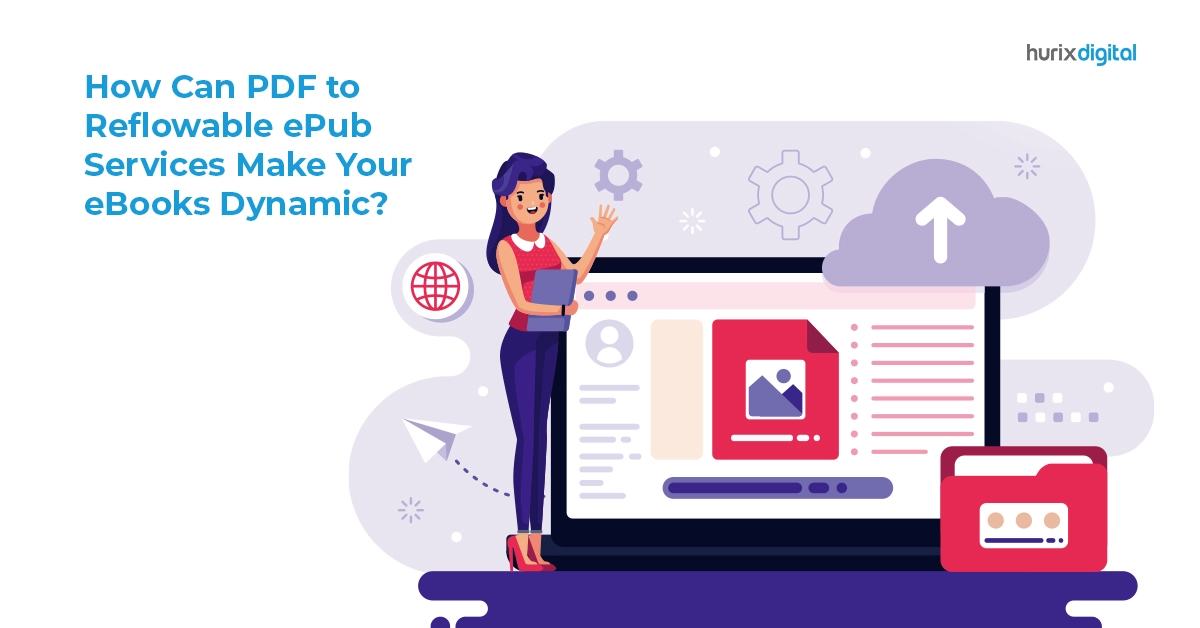The rise of digital technology has opened up fresh avenues for digital publishers and authors to add features such as audio, video, graphics and animations to their content and make their storytelling more exciting, engaging, immersive and entertaining. Features such as gamification and simulation are increasingly being used by organizations to liven up their training content and motivate learners to charter their own learning journeys. And since all this is not possible with content in a PDF format, it builds the case to convert your PDF content into eBook format that is PDF to ePub.
To give some context, eBooks, when they first came into being, were mainly available in the static PDF format. In other words, a PDF book is actually an electronic snapshot of the print book and cannot be customized or brought alive with audio-visual features. It can naturally be assumed that in a tech-savvy world, PDF books cannot live up to user expectations. The other drawback of PDF books is that they are not easily readable on various device types. To read a PDF file on a mobile device, readers have to scroll both horizontally and vertically, which hinders their reading experience. The ePUB format helps to overcome these limitations.
What is ePUB Format?
It is a format which has been developed and maintained by International Digital Publishing Forum (IDPF) and is supported by the Book Industry Study. It is an open-source format and over the period, it has evolved with the changing technologies. The latest version is ePUB3. It is a dynamic format and is supported by technologies such as HTML5 and CSS3, which make it possible to hyperlink content with internal and external references. Besides, ePUB3 is SEO-friendly, making content searchable on various browsers, based on keywords.
ePUB3 supports two types of layouts, fixed and reflowable. As the name suggests, the fixed layout exactly replicates the printed page. The images remain statically positioned relative to the text and so does the font size. In reflowable ePUB, the content flows to take up the shape of the device screen so that readers don’t have to zoom or scroll to read. So, whether they read the eBook on a PC or mobile, their reading experience remains the same. Here are the 9 Best Cross-Platform eBook Readers.
But as a digital publisher, you may already have eBooks and training materials in PDF format. The good news is that this material will not go to waste and you can convert your static PDF files into a dynamic ePUB format, which supports digital media and is readable on all device types including computers, tablets and smartphones. Here are the benefits of ePUB over PDF
It is relatively easy to convert a PDF to ePUB using special software. You will need to sign up with an eLearning content development services provider who will provide you access to the software. Once you log in, the software will help you convert your PDF files into the ePUB format, allowing you to add different media formats to improve your content and make it readable on multiple devices.
Here are 10 benefits of converting files from PDF to ePUB.
- Better Reader Experience: PDF was designed for the PC era, while ePUB is designed for mobiles and tablets, allowing content to reflow to fit the screen Readers don’t have to zoom or scroll to read a file.
- Searchable and SEO-friendly Content: Since ePUB is supported by HTML5, content can be interlinked to both internal and external resources, thereby extending the learners’ journey. Besides, the SEO capabilities ensure that end-users can search and find your content online using related keywords.
- Global Language Support: ePUB offers global language support and can handle the flow of text LTR or RTL. You can therefore convert your content into multiple languages and reach a wider audience.
- Interactive Content: You can add features including audio/video, graphics, animations, simulations, and infographics to convey a message, making the content more understandable, palatable and digestible for your audience. A picture speaks louder than words and so audio-visual content will leave a greater impact and provide an enhanced learning experience.
- Improved Analytics: ePUB supports analytical tools that allow you to collate, interpret and present data in an easy-to-consume format such as infographics, diagrams and figures for better decision-making. Besides, it also includes features for surveys and polls, which you can use for consumer insights.
- Traceable Content: Organizations, over the period, end up with a huge library of content in the form of presentations, research papers, training manuals and more. It is very difficult to interlink this vast repository of data manually. ePUB incorporates traceability features that allow you to trace the content you want, when you want and use it to your benefit.
- Open Source: Since ePUB is an open-source format, a global community is constantly working on its features to provide an enhanced reading experience and ensure its compatibility with other formats. PDF on the other hand is a proprietary format owned by ISO, which makes it difficult to edit and convert documents into other formats.
- Secure Content: Another major benefit of converting PDF into ePUB is that ePUB supports Digital Rights Management or DRM standards. This prevents unauthorized access and sharing of your content. This safeguards its copyright and use and also translates into more revenue from authorized sales and purchases.
- Text and Speech Features: By converting your PDF books into ePUB, you can add features such as talk-aloud, pronunciation, text intonation and other interactive features. With this, you can increase the end-user reach, especially people with disabilities such as audio or visual impairment.
- Greater Control to The End-learners: Since ePUB allows for hyperlinking and interactive ebook features, learners are no longer restricted to the information provided in the content. Rather, they can use these features to further broaden their horizons. Features such as assessments, quizzes etc., also allow learners to gauge their mastery of the modules.
In conclusion:
In this digital era, static content can no longer hold readers’ attention. Besides, tools and features created for the computer era no longer hold relevance in the age of the mobile. It, therefore, makes business sense for digital publishers and other organizations to digitalize their content and convert their PDF files to the ePUB format. The conversion process is not difficult once you have access to the right software. Also, this will give you time to revisit your existing PDF files and separate the useful content from the outdated, identify gaps and create new content in the ePUB format.







